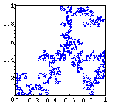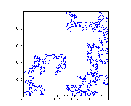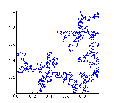Lab 10: Random Percolation
Take a sheet of graph paper and draw a 16x16 box square. Subdivide that square into four 8x8 box squares, randomly select one of those four 8x8 box squares, and shade that box in. You may use any method to randomly select the square to be shaded. You might number four slips of paper and repeatedly select a number from a hat, you might use four playing cards (Ace, 2, 3, 4), or you might use a four-sided die. You have now shaded one 8x8 box square.
Subdivide each of the three remaining 8x8 box squares into four 4x4 box squares, randomly select one of those squares in each group of four 4x4 box squares, and shade that square. You have now shaded three additional 4x4 box squares.
Subdivide each of the nine remaining 4x4 box squares into four 2x2 box squares, randomly select one of those squares in each group of four 2x2 box squares, and shade that square. You have now shaded nine additional 2x2 box squares.
Subdivide each of the twenty-seven remaining 2x2 box squares into four 1x1 box squares, randomly select one of those squares in each group of four 1x1 box squares, and shade that square. You have now shaded twenty-seven additional 4x4 box squares.
Lay another sheet of graph paper over your original (or simply fold your original sheet carefully over the figure) and shade over every box that was not shaded in the original figure.
You can also play this game by starting with larger boxes (32x32, 64x64, ...), and below you see some results generated by a computer. Click on an image to view it larger in a separate tab.


